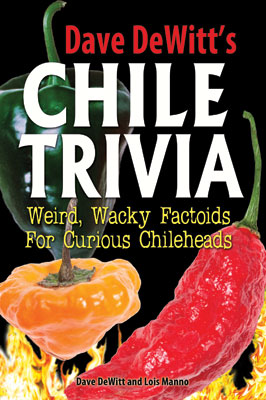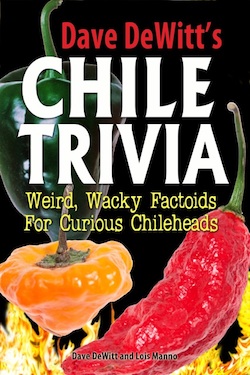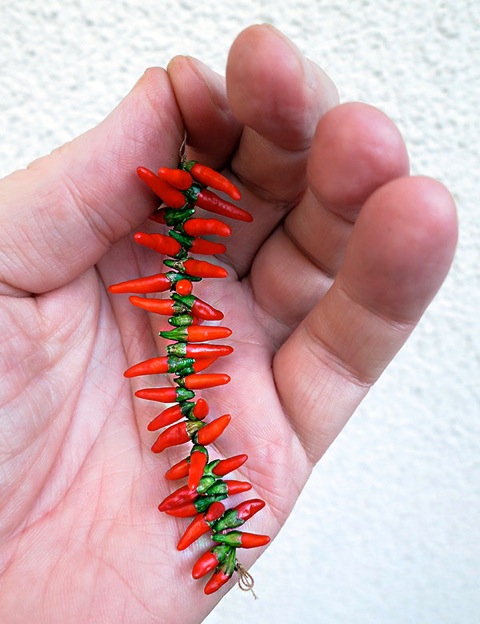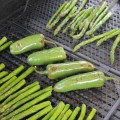 Dave DeWitt’s Chile Trivia is the newest book from the Pope of Peppers, coauthored by yours truly. It’s chock-full of interesting, fun factoids about chile peppers and spicy food, with fiery quizzes and quotes from famous chileheads worldwide. There’s a handy Scoville Scale, chile chronology, and pungency ratings for superhot chiles. If you haven’t picked up your copy yet, you can order it on amazon.com here.
Dave DeWitt’s Chile Trivia is the newest book from the Pope of Peppers, coauthored by yours truly. It’s chock-full of interesting, fun factoids about chile peppers and spicy food, with fiery quizzes and quotes from famous chileheads worldwide. There’s a handy Scoville Scale, chile chronology, and pungency ratings for superhot chiles. If you haven’t picked up your copy yet, you can order it on amazon.com here.
Here are a few excerpts from the book:
Do Men Like Spicy Food More Than Women Do?
When it comes to eating chile, there’s no proven biological link between gender and preference. If anything, blame the misconception that hot peppers are a “guy thing” on Madison Avenue. Whether they’re marketed as such or not, we all tend to think of everyday items, including food and beverages, as one gender or the other, says James Wilkie, a doctoral candidate in marketing at Northwestern University in Illinois.
According to Wilkie, humans instinctively categorize other individuals as male or female, but they don’t stop there. He says, “we tend to almost reflexively apply it to things that perhaps it’s not relevant to apply it to.” In a 2010 study, Wilkie examined how gender preconceptions affect people’s food choices. Men, more than women, he found, tend to be more concerned about choosing foods that conform to gender norms. For instance, they often choose rib-eye steaks, gravy and dishes described as “hearty” over supposedly feminine foods like salads. So screw the salad, girls…hot sauce isn’t just for guys.
Does This Mean Rats are Smarter than Chileheads?
Chile is a substance that most mammals will avoid as they would a poison. In contrast, birds and reptiles seem to be unaffected by its heat properties. Through a series of studies, psychologist Paul Rozin, Ph.D. found that it is practically impossible to induce a preference for chile peppers in rats, and subsequent experiments with dogs and chimpanzees have had limited success. A study he conducted in 1979 states that humans are the only mammals that “reverse their natural rejection” to bitter, “innately unpalatable substances” such as nicotine, coffee, alcohol, tobacco…and chile peppers. In fact, they can learn to prefer the flavor and physiological effects of these ingredients to the point of choosing to eat them regularly.
What’s the Earliest Known Cultivation of Chiles?
Chile peppers have long been popular in both horticultural and culinary circles – they’re believed to have been cultivated in different parts of Latin America as far back as 5200 B.C.
In fact, as a cash crop, peppers are next only to marijuana in per-acre profit…
—chile pepper breeder Dr. Ben Villalon
Does Environment Affect Chile Heat Levels?
It has long been assumed that about eighty percent of the heat level is fixed genetically and the remainder is determined by environmental factors. But some experts believe that the environment plays a much larger role than was originally assumed.
The questions arise because of apparently declining heat levels of domestically-grown habaneros. In recent high performance liquid chromatography tests at New Mexico State University, California orange habaneros have been measuring about 80,000 Scoville Units—far less than the 250,000 level of Habs from the Yucatán Peninsula, which were the progenitors of the domestic Habs.
Scientists have long known that stress factors—such as too little or too much water—can dramatically increase the capsaicin levels in the pods. But now they suspect that other environmental factors are operating as well, such as soil composition and pH, relative humidity, amount of ultraviolet radiation, fertilizers, and day and night temperatures. Therefore, chiles grown under near-perfect conditions would be milder than clones cultivated under stress.
A peculiar effect of capsicum is worth mentioning. In Mexico the people are very fond of it; and their bodies get thoroughly saturated with it, and if one of them happens to die on the prairie the vultures will not touch the body on account of its being so impregnated with the capsicum.
—Jethro Kloss, in his bestseller, Back to Eden
How Many Species of Chiles Are There?
There are five domesticated species of peppers, dozens of pod types within those species, and hundreds of varieties within the types. An example is “NuMex Big Jim,” which is a variety of the New Mexican pod type of the Capsicum annuum species. While the annuum species has many distinct types and varieties that have been named (Jalapeño, Bell, Serrano, etc.), the other species’ nomenclature is less developed. The species baccatum is generically called “Ají,” chinense is called “Habanero,” frutescens is called “Tabasco,” and pubescens is called “Rocoto.”
There is great pod type diversity within these other species, but most types have not been scientifically named. Many have local names that are unfamiliar to most of us. For example, although the entire chinense species is generically called Habanero (the name in Mexico), different pod types of this species have local names, such as Scotch bonnet in Jamaica, ‘Bhut Jolokia’ in India, datil in St. Augustine, goat pepper in the Bahamas, congo pepper in Trinidad, chombo in Panama, mutton pepper in Belize, and pimenta do cheiro in Brazil. As with the annuums, the chinense species has many different pod shapes and varying heat levels. It is just as inaccurate to call the entire chinense species “habanero” as it is to call the entire annuum species “jalapeño.” Confused yet?
I could have been a typical rich man’s brat and ridden fast women and walked with slow horses, and the company never would have made it. But I’ve given my time and my energies, such as I have been able to develop, to Tabasco®, and I’ve earned my position here.
—Walter S. McIlhenny, circa 1974
How Can I Make My Own Capsaicin Cream?
This will make a lotion, but you can make a cream by adding 6 ounces of melted beeswax to the warm, strained oil. Stir thoroughly and shake the bottle until cool.
8 to 10 ounces habanero chiles, chopped with the seeds
1 quart olive oil
Combine the ingredients and bring to a slow boil. Reduce heat and simmer very gently for 4 hours. Let cool for 4 hours. Repeat this procedure two more times.
Place the mixture in a blender and blend on high for 20 seconds.
Strain the mixture through a sieve that has been lined with muslin (pantyhose will do just as well) and place in small bottles.
Yield: 8 4-ounce containers of lotion or cream.
Variation: You can also enhance the formula by adding 40 drops of lavender oil to the strained lotion.
Caution: Do not rub your eyes after rubbing your skin with this cream!
Does Spicing Up Food Help With Dieting?
Diet-conscious chileheads rejoice! A study at Laval University in Quebec, Canada investigated the effects of capsaicin on feeding behavior and energy intake by adding spicy red pepper to whole meals, and then to appetizers. The results showed that the subjects’ appetites decreased both during and after capsaicin-rich meals, and a spicy appetizer beforehand lessened the amount eaten at lunch. This decrease in appetite lead to a subsequent drop in protein and fat intake. In other words: Put a little chile on your food, and you won’t eat as much. Try one of the many chile-laced chocolate bars on the market—you’ll find that it takes less to satisfy your sweet tooth.
Lois Manno
Latest posts by Lois Manno (see all)
- DIY Whole Wheat Flour Tortillas - 07/24/2018
- Green Chile Enchiladas - 07/23/2018
- SW Chocolate & Coffee Fest: A Caffeine Fiend’s Dream - 03/26/2013












Comments
love the website… great ideas for poppers though most of these ideas would work with hotter more exotic peppers as well, maybe not as big as the jalapeno but still good. I have been looking back through the archives and haven’t found anyone who may have done research on the best and or hottest salsas around ABQ area. Do you know of such a list and where can i obtain it. I think it would make for a great couple of evenings to just drive around sampling the best.
Thanks for all the great info and articles. see you at next years fest.
Hi T.,
Thanks for your comments. I don’t have a list of salsas that are specific to Albuquerque, but I suggest you download the free digital version of Burn!, the 2012 Fiery Foods & BBQ Show Program, where we have listed all the Scovie Winners as well as all the exhibitors from this year’s show. It’s a fantastic resource for any chilehead! You can click here to get the program.